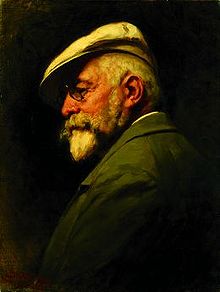Gyula Benczúr

Gyula Benczúr [ ˈɟulɒ ˈbɛntsuːr ] (born January 28, 1844 in Nyíregyháza , † July 16, 1920 in Dolány, today Szécsény ) was a Hungarian painter.
Life
Benczúr was born in 1844, the second of seven children to a pharmacist. In 1848 the family moved to Košice (today Košice / Slovakia). There Benczúr received drawing lessons from Franz Geyling , as well as Ferenc and Béla Klimkovics . After initial studies from 1861 at the Royal Academy of Arts in Munich with Hermann Anschütz and Johann Georg Hiltensperger , Benczúr studied between 1865 and 1869 with Carl Theodor von Piloty . He celebrated his first successes as a painter when he won the Hungarian national competition for historical pictures in 1870 with the picture The Baptism of Stephen the Holy (Vajk megkeresztelése).
He participated in Piloty's frescoes for the Maximilianeum and the town hall in Munich and illustrated works by Friedrich Schiller . Bavaria's King Ludwig II also commissioned him with work.
In 1876 he accepted a professorship for history painting at the Munich Art Academy . In Munich he was a member of the artist society Allotria . Based on the plans of his brother Béla Benczúr, he built a house in Ambach , on the east bank of Lake Starnberg , where he then spent his summer vacation. In 1883 Benczúr returned to Hungary and became a professor at the "School of Painting".
He painted portraits of kings and aristocrats, as well as monumental historical paintings . He also painted altarpieces for St. Stephen's Cathedral in Budapest and for the Hunyadi Hall of the Royal Palace of Buda . He also often painted mythological subjects.
Among his students was u. a. the Annaberg painter Rudolf Köselitz , the younger brother of Nietzsche's disciple Peter Gast .
gallery
The Siege of Buda (1686)
The baptism of Vajk ( Stephan I (Hungary) )
Count Gyula Andrássy
Farewell to Ladislaus Hunyadi
The arrest of Francis II Rákóczi
literature
- Gyula Benczúr . In: General Artist Lexicon . The visual artists of all times and peoples (AKL). Volume 8, Saur, Munich a. a. 1993, ISBN 3-598-22748-5 , p. 612.
- Horst Ludwig: Benczúr, Gyula . In: Horst Ludwig (Hrsg.): Bruckmanns Lexikon der Münchner Kunst . Munich painter in the 19th and 20th centuries Century . Volume 1, Verlag F. Bruckmann, Munich 1981, p. 81
Web links
- Literature by and about Gyula Benczúr in the catalog of the German National Library
- bilder-geschichte.de general information
- batz-hausen for more information
- Gyula Beczúr at the Academy of Fine Arts in Munich
| personal data | |
|---|---|
| SURNAME | Benczúr, Gyula |
| BRIEF DESCRIPTION | Hungarian painter |
| DATE OF BIRTH | January 28, 1844 |
| PLACE OF BIRTH | Nyíregyháza |
| DATE OF DEATH | July 16, 1920 |
| Place of death | Dolány, today Szécsény |







